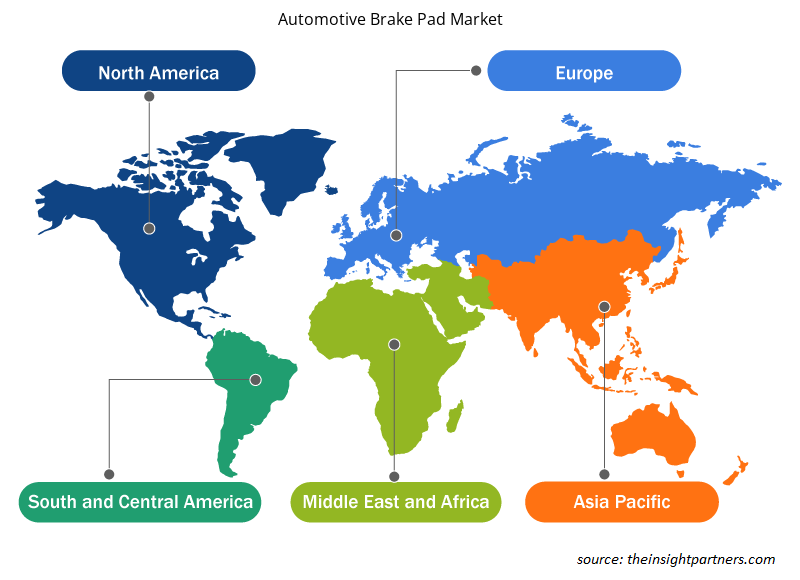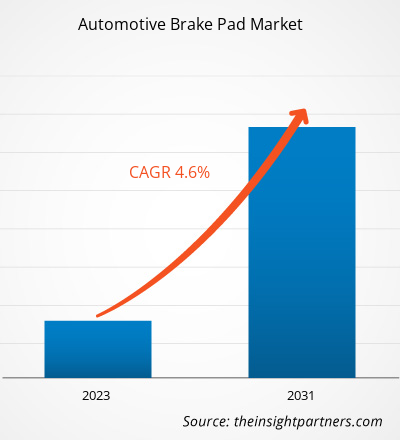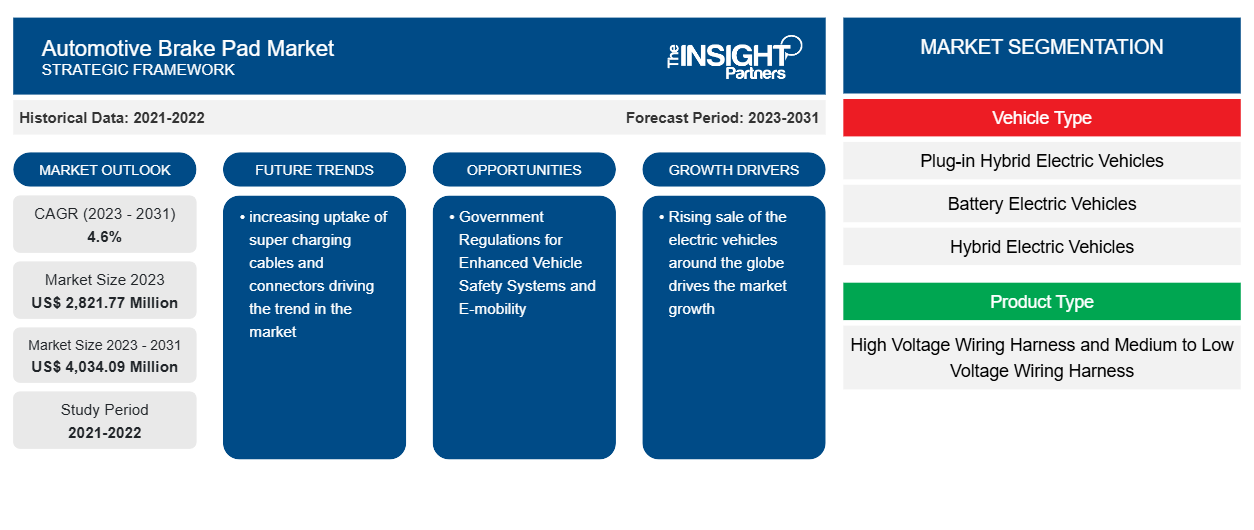汽车刹车片市场规模预计将从 2023 年的 28.2177 亿美元增至 2031 年的 40.3409 亿美元。预计 2023-2031 年期间市场复合年增长率为 4.6%。商用车和乘用车销量和产量的不断增长推动了市场的发展趋势。
汽车刹车片市场分析
助力器和电动机械系统的技术发展、高性能车辆的使用增加以及为提供更好的安全性而对盘式制动器的需求增加,正在推动汽车盘式制动器市场的增长。然而,盘式制动器的高制造成本可能会抑制汽车盘式制动器市场的增长。此外,预计在预测期内,商用车中空气盘式制动器的使用增加以及碳陶瓷刹车片的采用增加将为汽车盘式制动器创造市场机会。
汽车刹车片市场概况
全球汽车盘式制动器市场生态系统的主要利益相关者包括硬件/组件供应商、汽车盘式制动器制造商、标准和监管制定机构以及最终用户。组件/硬件供应商向盘式制动器制造商提供各种组件/零件/原材料,用于制造最终产品。刹车片、排气螺钉、卡钳、转子和硬件。
盘式制动器由铸铁、铝、不锈钢等制成。全球汽车盘式制动器市场的一些主要市场参与者/制造商包括赛默飞世尔科技公司、Brembo SPA、大陆集团、克诺尔制动集团和罗伯特博世有限公司等。刹车片主要用于乘用车,但由于其在制动阻力和更高速度下的稳定性能,它们正在扩展到商用车领域。在商用车中,鼓式制动器正在被盘式制动器取代,因为它们提供更高的质量和更长的使用寿命。Akebono 等公司也提供盘式制动器。
定制此报告以满足您的需求
您可以免费定制任何报告,包括本报告的部分内容、国家级分析、Excel 数据包,以及为初创企业和大学提供优惠和折扣
-
获取此报告的关键市场趋势。这个免费样品将包括数据分析,从市场趋势到估计和预测。
汽车刹车片市场驱动因素和机遇
全球道路事故数量不断增加,交通拥堵加剧,推动市场增长
市场上还有其他几个外围利益相关者,他们在推动汽车盘式制动器的增长和技术进步方面发挥着至关重要的作用。由于车辆引起的道路事故数量不断增加,需要制定安全法规,这又加剧了对制动系统规则和道路安全的需要。根据世界卫生组织的数据,每年约有 119 万人死亡。汽车刹车片市场的主要终端用户包括乘用车和商用车。此外,全球城市地区交通拥堵问题日益严重,在预测期内推动了对汽车刹车片产品的需求。
电动汽车销量增加为市场增长创造了充足的机会
电动汽车使用刹车片来满足车辆的制动要求。刹车片有助于避免事故。随着电动汽车 (EV) 行业的不断发展,制动系统的采用也呈指数级增长。为了减少排放对环境的有害影响,全球政府机构正在采取必要措施推广电动汽车。例如,电动汽车倡议是一个多政府政策论坛,旨在促进电动汽车的引进和采用。随着电动汽车使用量的增加,使用先进制动系统的范围也将扩大。许多电动汽车同时使用再生制动系统和机械制动系统。在电动汽车制动系统中,再生制动系统和机械制动系统有助于节省能源。
汽车刹车片市场报告细分分析
有助于得出汽车刹车片市场分析的关键部分是材料类型、车辆类型和地理位置。
- 根据材料类型,市场分为金属刹车片、半金属刹车片、陶瓷刹车片、石棉刹车片和非石棉有机刹车片。其中,金属刹车片在 2023 年占有最大份额,这是由于全球乘用车需求增加。
- 根据车辆类型,市场分为商用车和乘用车。其中,乘用车市场在 2023 年占有较大份额,这是由于全球乘用车的份额。根据国际汽车制造商组织的数据,2023 年全球乘用车销量从全球的 5860 万辆增加到 6520 万辆。
汽车刹车片市场份额按地区分析
汽车刹车片市场报告的地理范围主要分为五个区域:北美、亚太、欧洲、中东和非洲、南美和中美。
亚太地区被认为是增长最快的经济地区,中国和印度分别是世界第一和第三大增长最快的经济体。日本是该地区技术最先进的国家,为汽车轮胎市场的发展提供了机会。越南、马来西亚和印度尼西亚等东南亚新兴经济体的乘用车销量正在增长,因此预计汽车刹车片的需求将会增加。
由于美国和加拿大汽车销量的增长,北美正在快速增长。北美自由贸易协定 (NAFTA) 是美国、加拿大和墨西哥签署的一项协议。该协议降低了三国之间自由贸易和投资的大部分关税和非关税壁垒。这进一步帮助提高了北美国家的贸易和投资水平。此外,墨西哥正在成为汽车制造强国(北美自由贸易协定),过去几年来,墨西哥每月向美国供应价值超过 43 亿美元的零部件和价值 26 亿美元的整车。
汽车刹车片市场区域洞察
Insight Partners 的分析师已详细解释了预测期内影响汽车刹车片市场的区域趋势和因素。本节还讨论了北美、欧洲、亚太地区、中东和非洲以及南美和中美洲的汽车刹车片市场细分和地理位置。

- 获取汽车刹车片市场的区域特定数据
汽车刹车片市场报告范围
| 报告属性 | 细节 |
|---|---|
| 2023 年的市场规模 | 28.2177亿美元 |
| 2031 年市场规模 | 40.3409亿美元 |
| 全球复合年增长率(2023 - 2031) | 4.6% |
| 史料 | 2021-2022 |
| 预测期 | 2023-2031 |
| 涵盖的领域 |
按车辆类型
|
| 覆盖地区和国家 |
北美
|
| 市场领导者和主要公司简介 |
|
市场参与者密度:了解其对商业动态的影响
汽车刹车片市场正在快速增长,这得益于终端用户需求的不断增长,而这些需求又源于消费者偏好的不断变化、技术进步以及对产品优势的认识不断提高等因素。随着需求的增加,企业正在扩大其产品范围,进行创新以满足消费者的需求,并利用新兴趋势,从而进一步推动市场增长。
市场参与者密度是指在特定市场或行业内运营的企业或公司的分布情况。它表明在给定市场空间中,相对于其规模或总市场价值,有多少竞争对手(市场参与者)存在。
在汽车刹车片市场运营的主要公司有:
- 科络普弗里茨穆勒有限公司两合公司
- 藤仓有限公司
- 古河电气工业株式会社
- Motherson Sumi 系统有限公司
- 耐克森汽车电气有限公司
- 信邦电子公司
免责声明:上面列出的公司没有按照任何特定顺序排列。

- 了解汽车刹车片市场主要参与者概况
汽车刹车片市场新闻和最新发展
汽车刹车片市场通过收集一手和二手研究后的定性和定量数据进行评估,其中包括重要的公司出版物、协会数据和数据库。以下列出了汽车刹车片市场的一些发展情况:
- 德尔福宣布推出全新系列 BEV 刹车片,专门满足 BEV 应用的特定需求。根据详细比较,该系列是当今世界上最全面的系列之一,涵盖了独立售后市场最受欢迎的车型。车型包括日产聆风和特斯拉 Model S/Model 3,以及宝马 i4/iX、梅赛德斯 EQC/EQEE/QS 和保时捷 Taycan/Cross Turismo 等最新车型。德尔福推出 52 个零件编号,涵盖欧洲 270 万辆在役车辆,为维修厂提供了大量服务机会。(来源:公司网站,2024 年 2 月)
- Allied Nippon 推出了 EV+,这是一款全新的全功能电动汽车刹车片系列。(来源:新闻稿,2023 年 6 月)
汽车刹车片市场报告覆盖范围和交付成果
“汽车刹车片市场规模和预测(2021-2031)”报告对以下领域进行了详细的市场分析:
- 范围内涵盖的所有主要细分市场的全球、区域和国家/地区汽车刹车片市场规模和预测
- 汽车刹车片市场趋势以及市场动态,如驱动因素、限制因素和关键机遇
- 详细的 PEST 和 SWOT 分析
- 汽车刹车片市场分析涵盖主要市场趋势、全球和区域框架、主要参与者、法规和最新市场发展
- 行业格局和竞争分析,涵盖市场集中度、热图分析、知名参与者以及汽车刹车片市场的最新发展
- 详细的公司简介
- 历史分析(2 年)、基准年、预测(7 年)及复合年增长率
- PEST和SWOT分析
- 市场规模、价值/数量 - 全球、区域、国家
- 行业和竞争格局
- Excel 数据集
近期报告
客户评价
购买理由
- 明智的决策
- 了解市场动态
- 竞争分析
- 客户洞察
- 市场预测
- 风险规避
- 战略规划
- 投资论证
- 识别新兴市场
- 优化营销策略
- 提升运营效率
- 顺应监管趋势























 获取免费样品 - 汽车刹车片市场
获取免费样品 - 汽车刹车片市场